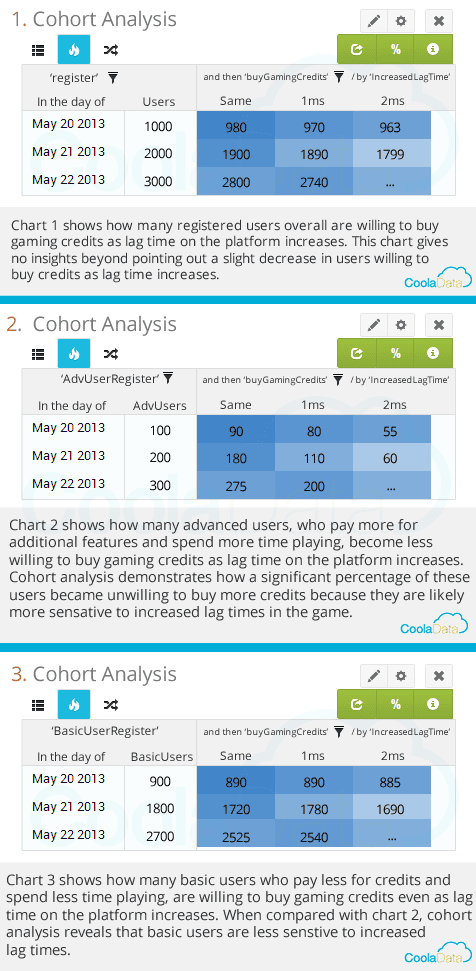
Cohort analysis is a powerful tool for understanding customer behavior over time. By grouping customers based on shared characteristics, businesses can identify patterns that help improve engagement and retention. Companies can make informed decisions to enhance customer lifetime value.
For example, cohort analysis can reveal when users are most likely to drop off after signing up for a service. Identifying these critical moments allows businesses to implement strategies to reduce churn and boost retention rates. This method is essential for any business aiming to understand its customers better and make data-driven decisions.
Whether you’re looking to improve your product or tailor marketing efforts, cohort analysis provides valuable insights. It enables you to see the effects of specific changes on different groups of users, helping you to pinpoint successful strategies and areas needing improvement.
Image Credit: Photo.iep, CC BY-SA 3.0 https://creativecommons.org/licenses/by-sa/3.0, via Wikimedia Commons
Breaking Down the Power of Cohort Analysis
Understanding Cohort Analysis
Cohort analysis is a powerful tool that helps businesses understand how different groups of customers behave over time. A cohort is simply a group of people who share a common characteristic, like signing up for a service in the same month or making their first purchase during the same week. By analyzing the behavior of these cohorts, businesses can identify trends, measure customer engagement, and make data-driven decisions.
Why Cohort Analysis Matters
Cohort analysis is valuable because it goes beyond looking at overall trends and delves into the specific experiences of different customer groups. For example, instead of just knowing that your overall customer retention rate is 60%, cohort analysis can reveal that customers who signed up in January have a 75% retention rate, while those who signed up in March only have a 45% retention rate. This information can help you pinpoint areas for improvement and tailor your strategies to specific customer segments.
Key Metrics in Cohort Analysis
Several key metrics are commonly used in cohort analysis, including:
- Retention Rate: The percentage of customers who continue to use your product or service over time.
- Churn Rate: The percentage of customers who stop using your product or service over time.
- Customer Lifetime Value (CLTV): The average amount of revenue a customer generates throughout their relationship with your business.
- Average Order Value (AOV): The average amount of money customers spend per transaction.
Cohort Analysis in Action
Let’s look at a hypothetical example of cohort analysis in the e-commerce industry:
| Cohort (Signup Month) | Month 1 | Month 2 | Month 3 |
|---|---|---|---|
| January | 1000 | 800 | 700 |
| February | 1200 | 950 | 850 |
| March | 1500 | 1100 | 900 |
In this table, each row represents a cohort of customers who signed up in a specific month. The columns show the number of customers who remained active in each subsequent month. By analyzing this data, the e-commerce business can see that retention rates tend to decline over time, and that the February cohort had a higher retention rate than the January and March cohorts. This information can help them identify potential issues and develop strategies to improve customer retention.
Benefits of Cohort Analysis
Cohort analysis offers numerous benefits for businesses, including:
- Improved customer retention: By understanding why customers churn, businesses can develop targeted strategies to keep them engaged.
- Increased customer lifetime value: By identifying high-value customer segments, businesses can focus their efforts on acquiring and retaining these customers.
- Better product development: By analyzing how different cohorts use your product, you can identify areas for improvement and develop features that resonate with your target audience.
- Data-driven decision-making: Cohort analysis provides valuable insights that can help you make informed decisions about marketing, pricing, and product development.
In conclusion, cohort analysis is a valuable tool for businesses of all sizes and industries. By understanding how different groups of customers behave over time, you can make data-driven decisions that improve customer retention, increase revenue, and drive long-term growth.
Key Takeaways
- Cohort analysis groups customers by shared characteristics.
- It helps identify patterns in customer behavior and retention.
- Businesses can use it to optimize strategies and reduce churn.
Fundamentals of Cohort Analysis
Cohort analysis helps businesses understand customer behavior and make informed decisions. It involves analyzing groups of customers to identify patterns and insights.
Understanding Cohorts
A cohort is a group of individuals who share a common characteristic within a specific time frame. Cohorts can be based on factors like the date of customer acquisition, user sign-up month, or purchase behavior. Analyzing these cohorts allows businesses to track changes over time and compare different groups.
For example, acquisition cohorts group users by the time they became customers. Time-based cohorts can reveal changes in user behavior over several periods. Size-based cohorts focus on groups of similar customer size. Identifying these cohorts helps in targeting marketing strategies and assessing product performance.
Key Metrics and Terms
Key metrics in cohort analysis include retention rate, churn rate, and customer lifetime value. The retention rate measures how many customers continue to use a product over time. The churn rate indicates the percentage of customers who stop using the product.
Customer lifetime value represents the total revenue expected from a customer during their relationship with a business. Tracking engagement metrics helps evaluate user interactions with a product, while vanity metrics may provide less actionable insights. These metrics help businesses understand customer loyalty and identify areas needing improvement.
Importance in Business Analytics
Cohort analysis is crucial for business analytics as it helps track customer behaviors and trends. Marketers use cohort analysis to refine campaigns and improve customer retention by identifying effective strategies. Sales teams can evaluate customer data to boost acquisition and retention rates.
Product development benefits from understanding which features retain customers. Historical data from cohort analysis allows for better forecasting and planning. Informed business decisions stem from identifying successful patterns within different cohorts. These insights drive strategic planning and optimize marketing and sales efforts.
Cohort analysis aligns marketing, sales, and product development, enhancing decision-making processes and improving overall business performance.
Implementing Cohort Analysis
Implementing cohort analysis involves selecting the right software, designing a study, optimizing marketing efforts, and improving customer experiences. Here are detailed steps on how to achieve this.
Analytical Tools and Software
Choosing the right tools is crucial. Tools like Excel or Google Sheets can handle basic cohort analysis. For larger datasets and advanced needs, consider using specialized software like Google Analytics or marketing analytics platforms.
Behavioral analytics platforms can provide deeper insights. These tools help track users over time and segment them based on specific actions or traits.
Key Considerations:
- Ease of use
- Integration with existing systems
- Real-time data processing
- Cost
These factors help ensure the chosen tools meet the organization’s needs.
Designing a Cohort Study
Designing a cohort study begins with defining the cohort. This could be based on user sign-up dates, purchase dates, or other significant events. It is important to align the cohort definition with business goals.
Select the right dataset for analysis ensuring it includes relevant metrics like engagement and conversion rates. Prepare for data collection and cleaning.
Create a cohort study by setting a timeline for follow-ups and analysis points. This helps in understanding how user behavior changes over time.
Optimizing Marketing and Sales
Using cohort analysis in marketing helps identify which strategies drive engagement and reduce churn. By segmenting users, marketers can tailor messages and campaigns to specific groups.
Effective Methods:
- Analyze the impact of different marketing channels
- Track conversion metrics by cohort
- Adjust campaigns based on cohort performance
Sales teams can benefit by understanding which cohorts show higher conversion rates and revenue per user, helping in targeting efforts and improving sales practices.
Enhancing Customer Experience
Cohort analysis can greatly improve user experience by identifying pain points and areas for improvement. By examining cohorts, companies can see how changes in customer service or product features affect user satisfaction and engagement.
Applications:
- Improving product development based on user feedback
- Enhancing customer service practices
- Personalizing user experiences to drive higher satisfaction
Using insights from cohort analysis, businesses can make data-driven decisions that enhance the overall customer experience, leading to increased loyalty and reduced churn.
Frequently Asked Questions
This section answers common questions about cohort analysis, covering its implementation in Excel, Python, marketing, education, and more.
How is cohort analysis typically implemented in Excel?
Excel is often used for cohort analysis because of its powerful data manipulation and visualization capabilities. Users can employ pivot tables and functions like SUM() and AVERAGE() to calculate cohort metrics over time. Using charts, users can create visual representations of cohort data, making trends easy to see.
What are common methods for performing cohort analysis using Python?
In Python, cohort analysis is commonly done using libraries such as pandas and matplotlib. These tools help in grouping data by cohort and visualizing the retention or drop-off rates. One approach is to assign cohort labels based on joining dates and then track these cohorts’ behavior over time using dataframes and visualization libraries.
What steps are involved in conducting a cohort analysis in a marketing context?
In marketing, cohort analysis tracks customer behavior and retention. The steps usually include collecting data, defining cohorts (e.g., by acquisition date), analyzing behavior across cohorts, and identifying trends or patterns. This helps in understanding customer engagement and improving marketing strategies.
In what ways is cohort analysis applied within educational studies?
In educational studies, cohort analysis monitors student performance and retention. Researchers may group students by enrollment year or program and track their progress over time. This helps in identifying factors affecting student success and tailoring interventions to improve educational outcomes.
How do you interpret the results from a cohort analysis study?
To interpret cohort analysis results, look at key metrics like retention rates, lifetime value, or dropout rates across different cohorts. Identify patterns that indicate either positive or negative trends. Comparing cohorts can reveal the effectiveness of various strategies or interventions.
What are the best practices for creating visual representations of cohort analysis in Tableau?
In Tableau, start by organizing data into cohorts and calculating key metrics. Use line charts or heat maps to visualize cohort performance over time. Ensure that the visuals are clear and easy to understand, using consistent color schemes and labeling to highlight important trends.



